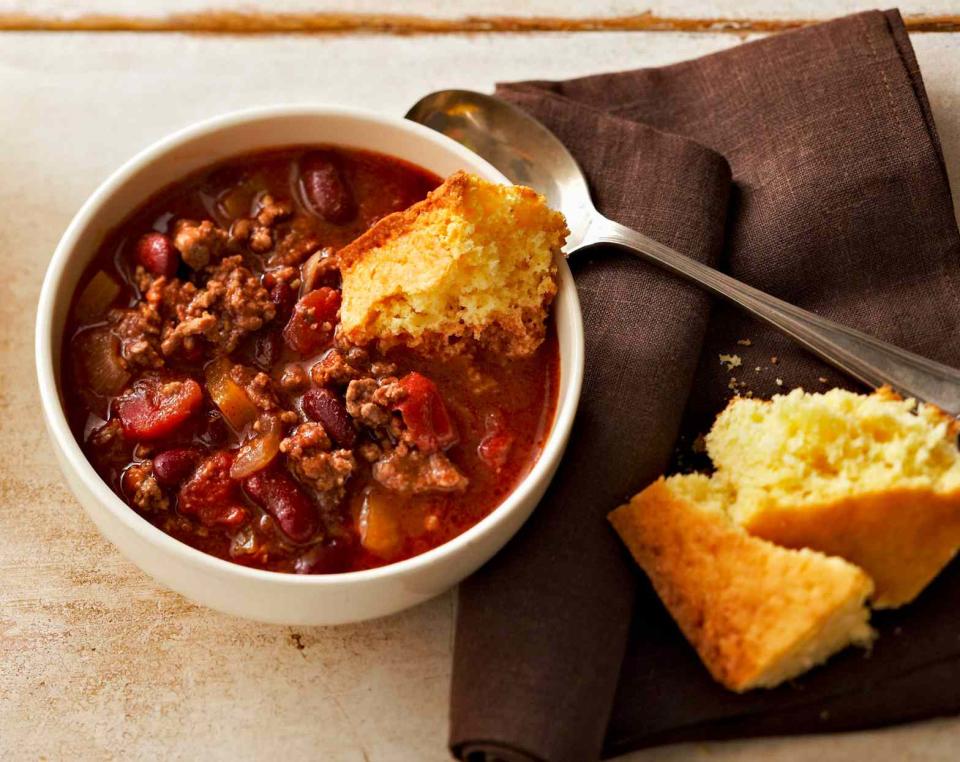How to Thicken Chili 7 Ways (And Prevent Thin Chili)
Follow these Test Kitchen tips for thick, hearty chili—and learn how to bolster your other favorite chili recipes without compromising flavor.

Whether it’s a blue ribbon-worthy classic chili recipe, a zesty white chili for your tailgate menu, or a slow cooker chili on blustery winter days, you and your dining companions are likely expecting a hearty dish. Traditionally, we expect a robust, spicy base, meat and/or beans, perhaps some bonus veggies, and a thick, rich consistency. Unlike soups, which are brothy, or even bisques, which are creamy yet thinner, chili is meant to be more stew-like; it’s a definite stick-to-your-ribs creation.
Fortunately, if your chili looks thinner than you’d like, there are a few tricks you can try to bolster your bowls. So, we're tapping our Test Kitchen pros for several ideas to make chili thicker (a.k.a., sturdy enough to stand up to dunking and copious toppings). While we’re at it, we’ll pick up some helpful know-how on how to prevent this culinary challenge before it happens.
Why is My Chili Thin?
If your chili ends up brothy, it is likely related to one of three issues—all of which boil down to a lack of liquid evaporation. This can be the result of:
Adding too much stock, broth, or water. A base of beef broth, chicken broth, or stock (and occasionally water, milk, or cream), sets the tone for most chili recipes. If your chili looks watery, you may have poured in more than required. Next time, add just a little at a time and increase the liquid as necessary.
Cooking it for a short time. Ideally, chili should simmer low and slow. This allows some of the liquid to evaporate and results in a thicker consistency and deeper, more complex flavor as the aromatics and spices release their superpowers.
Mixing in too many fresh or canned tomatoes. Tomato paste and sun-dried tomatoes lend more concentrated flavor and little to no moisture. Fresh or canned tomatoes—which are called for in nearly every red chili recipe—release a fair amount of water into the stew.
Related: 12 Homemade Beef Stew Recipes You'll Want to Serve This Winter

How to Thicken Chili
As you’ll see, several methods for thickening chili relate to removing or evaporating excess liquid. Other tricks from our Test Kitchen call for pantry staples that can tackle the task quickly without diminishing flavors.
Regardless of your preferred chili cooking method (Instant Pot, slow cooker, skillet, or Dutch oven) these are the best tried-and-true solutions for how to make chili thicker.
Simmer down. The easiest option for thickening chili is to let the problem solve itself over a slow simmer. Set the heat to low, take off the lid (if you’re using one), and allow your chili to gently bubble for an extra 15 minutes or until the liquid from the chili evaporates enough to reach the consistency you prefer.
Stir in some finely ground cornmeal or masa harina. Ground cornmeal is very effective at absorbing excess liquid and adds a subtle corn-like flavor. Just avoid coarse-ground cornmeal or polenta as they can lend a grainy texture to your chili. Start by stirring 1 to 2 tablespoons into your chili, allow the stew to simmer for 5 to 10 minutes more, and it should thicken up a bit. Masa harina (an instantly binding corn flour) also works beautifully to absorb liquid. Try masa harina in our Texas Chuck Roast Chili (pictured above).
Mix in a scoop of cornstarch, all-purpose flour, or oats. If you don’t have cornmeal or masa harina, you likely have one of these baking staples. Rather than adding it directly to the chili (which can create clumps) make a slurry. In a small bowl, mix 1 tablespoon of cornstarch with 1 tablespoon of water, then stir this into the pot of chili. For 1 tablespoon of flour, use 2 tablespoons of water. No slurry is required for the absorbent oats; simply stir in 1 to 2 tablespoons. In all cases, allow the chili to simmer for 5 to 10 minutes more, and you should notice it thicken up.
Pile on the vegetables. Unlike “wet” tomatoes, starchier vegetables like carrots, sweet potatoes, and potatoes can be a boon for thicker chili. Dice up ½ to 1 cup of extra root vegetables to add to the mix. The good news is, that these sturdy veggies will need additional simmer time to release their starches and get tender enough to spoon. That additional time on the stove will also help reduce liquids and elevate the flavors in your chili.
Try more tomato paste. Many chili recipes already call for this canned staple, so you likely already have cans or tubes of it on hand. Depending on the concentration of your tomato paste, add 2 tablespoons to ¼ cup more, stir, and cook on medium for 30 minutes more. The resulting chili should be richer, tangier-tasting, and thicker.
Mash some beans. Sorry, Texas chili purists, but beans can totally be your BFF when attempting to thicken chili. In a bowl, use a fork to smash ½ cup to 1 cup of kidney beans, pinto beans, or black beans into a paste. Stir this bean mash into the chili and allow it to simmer for 5 to 10 additional minutes.
Crumble up some corn chips. Normally, the crumbs of tortilla chips or corn chips at the bottom of the bag are a disappointment. But that’s exactly what you’re seeking here. Grab a handful of those already-crumbly bits, or place a few chips in a zip-top bag and crush with a rolling pin. Stir the corny crumbs into the chili, and let it simmer for 5 to 10 minutes more so they can melt into the stew. You may notice a bit more of a chewy consistency, but serve it with extra whole chips for scooping, and it will seem like this was all part of the grand dinner plan!
Related: The 6 Best Dutch Ovens of 2023, According to Our Testers
After trying any of these fixes for how to thicken up chili, take a taste test before you dish it up to share. Since we’re tinkering with the recipe and moisture balance, you’ll want to ensure the seasoning is still dialed in. Sprinkle in more salt, chili powder, onion powder, cumin, paprika, or cayenne pepper, if needed, then ladle it up, and dive in.
For more Better Homes & Gardens news, make sure to sign up for our newsletter!
Read the original article on Better Homes & Gardens.

